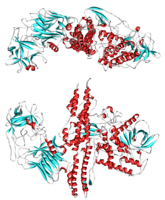
Photo from wikipedia
Abstract The determination of necrophagous fly specie's development time is considered an accurate method for estimating postmortem interval (PMI). However, pesticides and other chemicals can alter the flies' life cycle,… Click to show full abstract
Abstract The determination of necrophagous fly specie's development time is considered an accurate method for estimating postmortem interval (PMI). However, pesticides and other chemicals can alter the flies' life cycle, inducing errors in PMI estimation. Thus, this work aimed to evaluate the effect of different doses of Terbufos (Organophosphates) on the temporal dispersion pattern and development of immature dipterans associated with decaying rat carcasses. For this, 150 g female Wistar rats received, via gavage, 200 µl of Terbufos (5 or 10 mg/kg) or distilled water (control) and, after 30 min of administration, the animals were euthanized and distributed in suspended traps to decompose under environmental conditions. The dispersing immatures were collected daily, and their development time was monitored until the emergence of adult flies. After data analysis, it was observed that Terbufos altered 1) the temporal pattern of larval dispersion; 2) the composition and structure of the colonizing assemblage (emerged adults); 3) species' development time, accelerating or delaying their cycle, depending on the dose used; and 4) the califorids and sarcophagids emergence rate, increasing the mortality of pupae from intoxicated carcasses. Thus, this work demonstrates experimentally that Terbufos directly influences the development of flies with forensic potential and discusses the implications for PMI estimation, which can assist in future investigative processes with suspected poisoning by this organophosphate.
Journal Title: Journal of Medical Entomology
Year Published: 2020
Link to full text (if available)
Share on Social Media: Sign Up to like & get
recommendations!